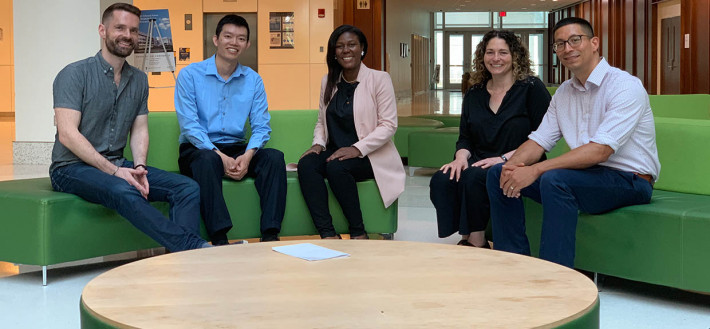Changing the Face of the IRP
Marie A. Bernard Leads NIH Efforts to Recruit “Great Minds That Think Differently”

Dr. Marie A. Bernard was selected as NIH’s Chief Officer for Scientific Workforce Diversity in October 2020.
The summer of 2020 will likely be remembered as a turning point in America. The murder of George Floyd and the disproportionate effects of the COVID-19 pandemic on communities of color brought the simmering scourge of racism and race-related disparities to the center of public debate and convinced many Americans that something needs to be done.
The biomedical research enterprise has long dealt with its own inequities as well, including outright discrimination against people from certain groups. As a result, a top priority of the National Institutes of Health is to bring greater equity to the scientific and medical workforce and the patients and communities it serves. In her new role as NIH’s Chief Officer for Scientific Workforce Diversity (COSWD), Marie A. Bernard, M.D., has big plans to push the needle further towards reaching that goal.
“In this role, I'm looking across all of NIH and beyond not at the research per se, but at the people who are doing the research, trying to make sure that we have as broad representation as possible so we can get a lot of diverse perspectives,” says Dr. Bernard. “If we're going to maintain our leadership role in biomedical research, that’s really essential.”
Researchers have long recognized that racial minorities often have less access to health care and receive poorer-quality care than non-Hispanic white individuals. These disparities can negatively impact the health and economic circumstances of people from those disadvantaged groups. What’s more, these inequalities are exacerbated by the relative scarcity of people from those communities in scientific and healthcare professions, as well as among participants in research studies. That leaves a huge hole in the perspectives and life experiences that inform research priorities and directions, makes research findings less applicable to already disadvantaged populations, and denies many patients the sense of trust and familiarity that comes with seeing themselves among decision makers and care providers.

Recruiting more scientists and clinicians of color can encourage patients from similar backgrounds to participate in clinical trials.
“With the disparities that we've seen in morbidity and mortality with COVID-19 and the videotaped murder of George Floyd, I think people have gotten very aware that there are disparities and that they are best addressed by having a more diverse group of people at the table and being much more inclusive,” Dr. Bernard says. “There’s now a focus that I've never seen before in my career.”
At every step of the research process, she says, these factors tend to build on each other, compounding the effects on how studies are conducted. Scientists from groups that are well-represented in biomedical professions sometimes don’t focus as much on recruiting study participants from other backgrounds, and individuals who see very few people similar to themselves among the ranks of doctors and scientists are understandably wary of signing up for studies led by researchers they have difficulty relating to. The problem is also exacerbated by the exclusionary criteria common in clinical trials. To control for external variables that could confound study results, researchers usually exclude people with illnesses outside of what is being studied. Unfortunately, these illnesses are more common in people from historically marginalized communities.
“By having multiple exclusions for chronic illnesses, you automatically eliminate populations that have those high burdens of disease,” Dr. Bernard explains.
Beyond improving our understanding of the many diseases that disproportionately affect people of color, Dr. Bernard says, diversity within research teams brings an expanded perspective to scientific inquiry, affecting the types of questions researchers ask. She gave the example of her own childhood neighborhood in Oklahoma, which had a nearby sanitation treatment plant that burned garbage two or three times a week. The pollution caused asthma rates to go up in her community. Someone who grew up in a neighborhood like that might ask questions about the biological effects of the pollution, whereas those who didn’t have that sort of experience may not ask the same questions.

Dr. Bernard’s work as NIH’s COSWD will help to bring a more diverse set of scientists to NIH.
Dr. Bernard brings to her new role a lengthy track record as a leader in creating a more diverse and inclusive community both at NIH and across the U.S. She joined NIH in 2008 to serve as the Deputy Director at the National Institute on Aging (NIA), where she became involved in leading NIH through a broad range of activities designed to end structural racism in biomedical research. For example, while still at NIA, she began working with the newly formed Office for Scientific Workforce Diversity, joining several of its advisory committees. She was also a founding member of the Office’s NIH Diversity Working Group and served on its Equity Committee, which was created to oversee the fair distribution of resources among scientists within the NIH Intramural Research Program. In addition, she served as co-chair of the NIH-wide Inclusion in Governance Committee, which ensures that NIH clinical studies include an appropriate mix of participants of differing races, ethnicities, and ages, as well as a roughly balanced number of men and women.
Dr. Bernard began serving as Acting COSWD in October 2020 following the departure of Hannah A. Valantine, M.D., NIH’s first-ever COSWD. Now, as COSWD, Dr. Bernard serves as co-chair of the NIH UNITE initiative, a program introduced in February 2021 that brings together diverse representatives from across NIH’s 27 Institutes and Centers to identify opportunities for improvement, recommend solutions, and implement strategies to address structural racism and increase inclusivity and diversity in all aspects of biomedical science on the NIH campus and across the rest of the country. In her role as COSWD, she is also working to add several new programs and expand existing ones, including developing a Scientific Workforce Diversity Seminar Series and enhancing recruitment to the NIH Distinguished Scholars Program, which specifically aims to accelerate the careers of scientists from groups under-represented in biomedical research.
“We have an adage on our website that I like to use in talks as well,” Dr. Bernard says. “We need lots of ‘great minds’ that ‘think differently.’”
Subscribe to our weekly newsletter to stay up-to-date on the latest breakthroughs in the NIH Intramural Research Program.
Related Blog Posts
This page was last updated on Monday, January 29, 2024
